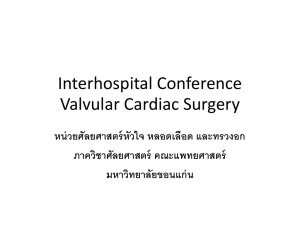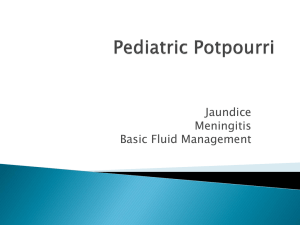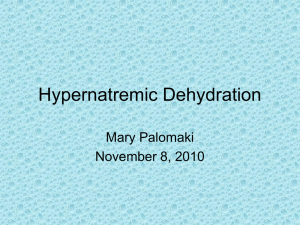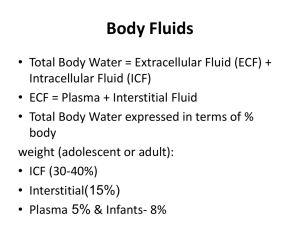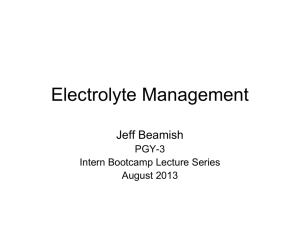Fluids and Electrolytes in Pediatrics 1/7/11
advertisement
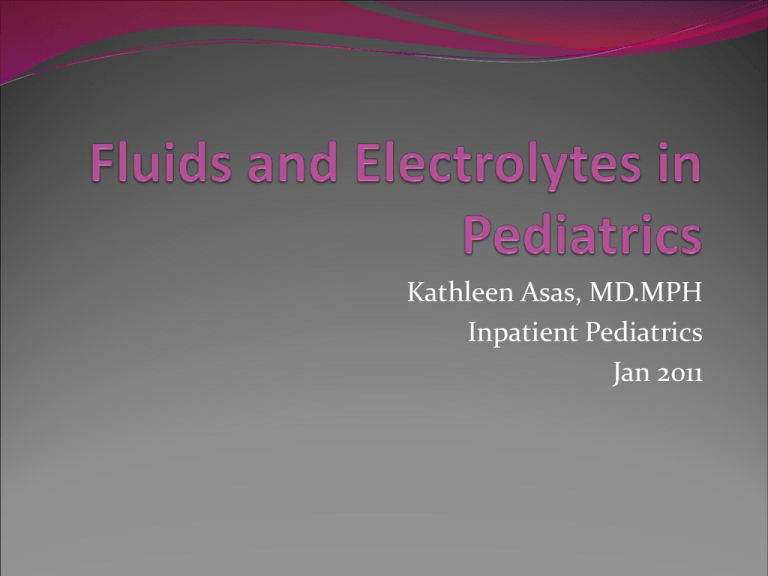
Kathleen Asas, MD.MPH Inpatient Pediatrics Jan 2011 Objectives To review basics of maintenance fluid and electrolyte requirements To gain comfort in classification of dehydration and options for fluid support To perform case-based practice! Back to Basics….Fluid compartments Total body water= ICF + ECF Total body water = 60-75 % of Body weight Important Concepts Plasma Osmolality= Concentration of solutes in blood Plasma Osmolality= 2 x plasma (Na) Change in plasma osmolality --> change in ECF osmolality with water movement across cell membranes Remember: The body has an immediate need to restore intravascular volume over osmolality. Total Body Water Composition by Age Concepts Maintenance: Normal ongoing losses of fluids and electrolytes Deficit: Losses of fluids and electrolytes resulting from an illness On-going Losses: Requirement of fluids and electrolytes to replace ongoing losses Factors Increasing Maintenance Fluid Requirements Fever-each 1 degree Celcius over 38 degrees increases maintenance fluid requirements by 12% Hyperventilation Increased temperature of the environment Burns Ongoing losses-diarrhea, vomiting, NG tube output Factors Decreasing Maintenance Fluid Requirements Skin: Mist tent, incubator (premature infants) Lungs: Humidified ventilator Mist tent Renal: Oliguria, anuria Misc: Hypothyroidism Goal of Fluid Therapy To prevent dehydration To prevent electrolyte abnormalities To prevent protein degradation To prevent acidosis and circulatory collapse Calculation of Maintenance Fluid Requirements…the Holliday-Segar Method Example: A 30-kg child would require (100 × 10) + (50 × 10) + (20 × 10) = 1,700 cc/day or (4 × 10) + (2 × 10) + (1 × 10) = 70 cc/h. Maintenance Electrolyte Requirements Na and K are the primary electrolytes that govern ECF and ICF osmolality. [Na] in ECF = 135-145 mEq/L, negligible in ICF [K] in ICF = 150 mEq/L, negligible in ECF Maintenance Electrolyte Requirements: Na: 2-3 mEq/100ml water /day OR 2-3 mEq/kg/day K: 1-2 mEq/100ml of water/day OR 1-2mEq/kg/day Chloride: 2 mEq/100ml of water /day Choosing MIVF..these are best estimates… 1. 2. 8kg infant: 8kg x 4ml/kg/hr 32 ml/hr Na: 15-30mEq/L K: 8-15 mEq/L D5 ¼ NS + 10meq KCl/L @ 32 ml/hr Wt-55 kg: Rate 95ml/hr Na: 45-68 mEq/L K: 22-45 mEq/L IVF: D5 ½ NS + 20 mEq KCl/L @ 95ml/hr 3. Wt-80kg: Rate 120ml/hr Na: 57.6-85 mEq/L K: 28.8-58 mEq/L IVF: D5 ½ NS + 20mEq KCl/L @ 120ml/hr Standard Na content in IVF: NS (0.9% NaCl) = 154 mEq/l Na ½ NS (0.45% NaCl) = 77 mEq/l Na 1/3 NS (0.33% NaCl) = 51 mEq/l Na ¼ NS (0.25% NaCl) = 39 mEq/l Na 1/5 NS (0.2% NaCl) = 31 mEq/l Na Standard K content in IVF: 10mEq KCl/L 20 mEq KCl/L 40 mEq KCl/L Concepts in Dehydration Initial loss of fluid from the body depletes the extracellular fluid (ECF). Gradually, water shifts from the intracellular space to maintain the ECF, and this fluid is lost if dehydration persists. Acute Illness (<3 days ): 80% of the fluid loss is from the ECF and 20% is from the intracellular fluid (ICF). Prolonged Illness (> 3 days): 60% fluid loss from ECF and 40% loss from ICF. Pre-Illness Weight Estimate of Dehydration Scenario 1 (if pre-illness wt known) Need to accurately monitor patient weights frequently Fluid deficit (L) = PIW (kg) – IW (kg) (Generally 100cc/kg) PIW = Pre-illness weight IW = Illness weight % Dehydration = PIW (kg) – IW (kg) x 100% PIW (kg) Scenario 2: (In ER) Need illness wt % DHN based on exam Step 1: Calculate pre-illness wt (PIW): Current wt = PIW wt (1-% DHN) Step 2: Calculate wt loss and respective deficit fluid volume PIW-IW = wt loss Note: 1kg ~ 1000ml fluid deficit Deficit Fluid volume= 100cc/kg wt loss Maintenance Electrolytes Oral Rehydration vs IVF…the Big Debate Oral Rehydration: Key Concepts Mild to moderate dehydration may be managed successfully with oral rehydration in the majority of cases. Oral rehydration solutions should contain glucose and sodium in a ratio not to exceed 2:1 Amount of rehydration solution to be given is based on the estimated percentage of dehydration by weight. Oral Rehydration Patient vomiting – 5-10mL Q 5-10 minutes and increase as tolerated Mild Dehydration – Deficit replacement: 50 mL/kg over 4 hours Moderate Dehydration – Deficit replacement: 100 mL/kg over 4 hours Developing a Plan of Action Determine degree of dehydration Establish phases (total of 3 phases- Resuscitation, Replacement, and Stabilization) Phase I: Resuscitation using Isotonic Fluids (NS/LR) at 20ml/kg. Re-evaluation until urine output and dehydration signs improved Phase II: Calculate maintenance & deficit fluid Hypotonic Na <130 Determine if Isotonic, Hypotonic or Hypertonic Dehydration Isotonic 130< Na <150 Hypertonic Na >150 Replace fluids over 48hrs** Phase I – Resuscitation phase Goal: Restore circulation, re-perfuse brain, kidneys Mild-Moderate 20 mL/kg bolus given over 30 – 60 minutes Severe May repeat bolus as needed (ideally up to 60ml/kg) Fluids – something isotonic such as NS or lactated ringers (LR) Phase II: Replacement Phase Phase III: Stabilization Phase (For Isotonic/Hypotonic Dehydration) Goal: Replace deficit of fluids and electrolytes Replacement Phase 1st 8 hrs Stabilization Phase Next 16 hrs MIVF and Maint Na 1/3 2/3 Deficit Fluid & Deficit Na 1/2 1/2 Hypertonic Dehydration Phase 2: Replacement Phase Goal: Replace deficit of fluids and electrolytes and daily maintenance Amount: Deficits + daily maintenance Fluid: Give over 24-48 hours IMPORTANT: Lower serum Na by no more than 10-12 mEq/L per day or <0.5mEq/L/hr Hypertonic Dehydration Phase 3: Stabilization Phase Goal: Replace ongoing losses and transition towards maintenance therapy Amount: Replacement + daily maintenance Exceptions: Severe Hyponatremia • Serum Na < 120, CNS symptoms Amount of 3# NaCl: (Desired Na-observed Na) x wt x 0.6L/kg 0.5mEq/L Remember 3% NaCl (0.5mEq Na/ml) The infusion should be given at a rate to increase the serum sodium by no more than 5 mEq/L/h and is often given more slowly over the course of 3–4 h • Do not replace Na faster than 10-12 meq/L per 24hrs. Why? Central pontine myelinosis: rapid brain cell shrinkage with rapid increase in ECF Na Steps in Fluid Replacement A. Phase I: Rapid Phase Restore intravascular volume a) Use Isotonic Fluid (NS/LR) b) Replace other components (Ca/glucose) separately based on documented deficit c) Volume: 10-20cc/kg; repeat up to 60cc/kg then re-evaluate B. Phase 2: Replacement Phase Determine type of dehydration based on Na-level (Isotonic, Hypotonic, or Hypertonic) a) Calculate 24-hr water needs Calculate maintenance water Calculate deficit water b) Calculate 24-hr electrolyte needs Calculate maintenance sodium and potassium Calculate deficit sodium and potassium c) Select an appropriate fluid (based on total water and electrolyte needs) Hypotonic and Isotonic Dehydration: Administer ½ calculated fluid during the 1st 8 hrs. Administer remainder over the next 16 hrs. C. Phase 3: Stabilization Replace ongoing losses as they occur (ex: diarrhea) a) Measure every 4-6 hrs and replace with appropriate fluids Exceptions: Treatment of Hypernatremic Dehydration Restore intravascular volume. Determine time for correction based on initial [Na]: [Na] 145-157 mEq/L : 24 hr [Na] 158-170 mEq/L: 48 hr [Na] 171-183 mEq/L: 72 hr [Na] 184-196 mEq/L: 84 hr Administer fluid at a constant rate over the time for correction Typical fluids: D5¼ NS or D5 ½ NS (with 20mEq/L KCl unless contraindicated) Follow serum Na Sodium decreases too rapidly- Increase [Na] of IVF or decrease rate of IVF Sodium decreased too slowly-Decrease [Na] of IVF or increase rate of IVF ***Lower serum Na by no more than 10-12 mEq/L per day Take Home Message Oral rehydration is a safe and effective intervention in patients with mild-to-moderate dehydration who are able to tolerate oral regimen. Fluid calculations are “best estimates.” Always monitor the effects of your interventions. Deficit fluid requirements are based on classification of dehydration. Hypotonic and isotonic dehydration are corrected in 8-hr and 16-hr blocks. Hypertonic dehydration is corrected based on Na level (usually over 48hrs). Slow correction of both hyponatremia and hypernatremia. Case: A 12 month old male is made NPO for surgery, wt-10 kg. What would be his maintenance fluid and electrolyte requirement? Case 1: Wt: 10kg Phase 1 (resuscitation): No resuscitation phase required Phase 2 (replacement): Maintenance Fluid: 10 x 4cc/hr 40ml/hr (or 1000ml/day) Maintenance Na: 2-3 mEq/100cc fluid 30 mEq Na/LD5 ¼ NS Maintenance K: 1-2 mEq/100 cc fluid 10 mEq/L KCl Maintenance fluid choice: D5 ¼ NS + 10mEq KCl/L at 40ml/hr Case 2 A 4 year old male presents with a history of vomiting and diarrhea. He has had 10 episodes of vomiting (clear then yellow tinged) and 8 episodes of diarrhea. The diarrhea is now watery and the last few episodes have been red in color. The diarrhea odor is very foul. He feels weak. Exam: VS T 38.2 degrees (oral), P 110, R45, BP 90/65, oxygen saturation 100% in room air. Wt- 18 kg. He is alert and cooperative, but not very active. He is not toxic or irritable. His eyes are not sunken. TMs are normal. His oral mucosa is moist but he just vomited. His neck is supple. Tachycardic, Bowel sounds are normoactive. His overall color is slightly pale, his capillary refill time is 2 seconds over his chest, and his skin turgor feels somewhat diminished. Questions Based on clinical criteria, what is his % dehydration? Option 1 (Calculate PIW) 18kg/(1-0.05)= 18.9 (PIW) 18.9kg – 18kg= 0.9 (100ml x 0.9) What method of fluid administration would you choose? The parents are insistent on IV fluids. What would be your steps in fluid administration? -Bolus of 20ml/kg -Re-assessment - IVF vs oral rehydration Oral versus IV rehydration is discussed with his parents who indicate that they have tried oral hydration and are not happy with the results so they would like the IV for him. An IV is started and a chemistry panel is drawn. Na 135, K3.4, Cl 99, bicarb 15. Wt-18kg. Phase I: resuscitation completed w/NS bolus Phase II: Determined Isotonic Dehydration Maint fluid: 1400ml Maint Na: 3 mEq/100ml 42 mEq Na/1400ml 30mEq/L Na Maint K: 2 mEq/100ml 28mEq K/1400ml-> 20mEq/L K Deficit fluid in 5% DHN: 18 x 0.05 x 1000-> 900ml -360ml 540ml < 3 days illness; 0.8 (900ml) 720ml (loss from ECF) 0.2 (900lm) 180ml (loss from ICF) Deficit Na: [Na] in ECF × vol deficit [ECF} 135 x 0.720L 97 mEq Na – 55mEq Na (received) 42 mEq Na Deficit K: [K] in ICF x proportion of fluid loss from ICF x deficit 150 x 0.180 L 27 mEq K 1st Phase: NS bolus (360ml, 55mEq Na received) 2nd phase: 1st 8 hr: Replace 1/3 of maintenance Na + H20 + ½ deficit Na and H20: Na: 10 mEq + 21 mEq-> 31mEq/735ml -> 42 mEq Na/L 465ml 270ml K: 7mEq + 14mEq 21mEq/735 28mEq/L K st 1 8hrs: 735 ml of D5 1/3 NS + 25mEq KCl/L @ 92ml/hr Next 16hrs: Replace 2/3 maint Na + H20 AND ½ deficit Na + H20: Na-> 20mEq+ 21mEq-> 41mEq Na/1205 ml 34mEq/L Na D5 1/4 NS K: 26mEq/1205ml 21mEq/L K Next 16hrs: 1205 ml of D5 1/4 NS + 20mEq K/L at 75ml/hr Question 5: DR is a 4 year old girl (16kg) who presents to the emergency room with fatigue,headache, generalized malaise, and severe gastrointestinal distress. The ER team gets a chem-7 and discovers her sodium to be 118. They would like to give 3% NaCl and ask you for a recommendation on how much to give, and at what rate. Answer Amount of 3# NaCl: (Desired Na-observed Na) x wt x 0.6L/kg 0.5mEq/L Remember 3% NaCl (0.5mEq Na/ml) Goal to increase Na by no more than 5mEq/L Calculation: (125-118) x 16 x 0.6L/kg 134ml of 3% NaCl over 3-4 hrs 0.5 mEq/L 5 kg child with 4-day h/o vomiting/diarrhea, 10% dehydration, [Na] of 128 mEq/L Fluid volume Na K (replacement over 2 days) Maintenance 5 x 100= 500ml 3mEq/100ml fluid 15 mEq 2mEq/100ml 10 mEq K Deficit 5 x 0.1 500ml [Na] in ECF x propor. Loss x fluid deficit + [obs Na-desired Na x wt x prop Na loss]: [K] in ICF x prop loss x fluid deficit: 150 x 0.2L 30 mEq K [ECF] loss 0.6 (500ml) 300ml [ ICF] loss 0.4 (500ml) 200ml 135 x 0.3L + [135-128x 5 x 0.6] 40mEq + 21 mEq 61 mEq Ongoing Losses Replace cc: cc Add Na in proportion to expected concentration in lost fluid (e.g., stool, gastric contents) Add K in proportion to expected concentration in lost fluid (e.g., stool, gastric contents Total 1000ml 61 + 15 = 76 mEq Na 40 mEq K 1st 8hrs: 165ml + 250ml: ~ 400ml 600ml 5mEq + 30mEq 35mEq Na/400ml: 165 ml 250ml 87 mEq Na/L 18 mEq KCl/L Next 16 hrs: 23 mEq KCl/L 10mEq Na + 30 mEq Na 40 mEq Na/600ml 66mEq Na/L 1st 8hrs: D5 ½ NS + 20 mEq K/L @ 50ml/hr Next 16hrs D5 ½ NS + 20mEq/L KCl @ 35-40ml/hr Determine adequate fluids for 7-kg child with 15%, Na=160 Fluid volume Na K (replacement over 2 days) Maintenance 700ml/day 3mEq/100ml fluid 21mEq Na 2mEq/100ml 14mEq K Deficit 7 x 0.15= 1050ml SFD= 630ml FWD-420 ml Free H20 deficit: 7kg x 4ml/kg x [Serum Nadesired Na] 420ml Na: [Na in ECF] x prop Na loss x [Solute deficit] [135 x 0.6] x [1050-420]=51 mEq Na [K] in ICF x prop loss x fluid deficit 38mEq Ongoing Losses Replace cc: cc Add Na in proportion to expected concentration in lost fluid (e.g., stool, gastric contents) Add K in proportion to expected concentration in lost fluid (e.g., stool, gastric contents 1st 24hr 24-hr maint + ½ Free H20 deficit + SFD: 700 + 210+ 630 1540ml Maint Na + Def Na 21mEq + 51 mEq 72 mEq 14mEq Solute Fluid + Elect Deficits Total Fluid Order: Next 24hrs 24-hr maint + ½ FWD 700ml + 210ml-> 910ml 38mEq 72mEq/1.54L 47 mEq Na/L D5 1/3 NS + 30mEq KCl/L @ 64ml/hr 52mEq/1.54L34mEq K/L 21mEq Na/0.91L 23mEq Na/L 14mEq/0.91ml 15mEq K/L D5 ¼ NS + 15mEq KCL/L @ 38ml/hr References Fleisher, G. et al. (2005). Renal and Electrolyte Emergencies. In Cronan, K. & Kost (Eds), Textbook of Pediatric Emergency Medicine. Kleigman, R. et al. Nelson Essentials of Pediatrics. Chapter 32: Fluids and Electrolytes. 5th edition. pp.157-163. Robertson, J. & Shilfoski, N. (2005). Fluids and Electrolytes. The Harriet Lane Handbook. (pp. 287-300). Sykes, R. (2007). Pediatric Fluids and Electrolytes. [PowerPoint slides].
